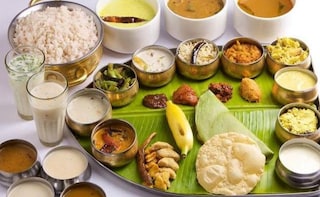Image Credits: Rasa, Bangalore
Erissery or Kootu Curry: One of these thick gravies is an integral part of a Sadya. The Erissery combines yellow pumpkins with a fried coconut gravy while the Kootu Curry is a mix of vegetables and Bengal gram (Chick pea).Kerala Pappadam: More bubbly and fluffy compared to its flatter crunchier counterparts in other parts of Southern India, the Kerala version is made with rice flour, lentils and baking soda and always deep-fried in fragrant coconut oil.Pachadi and Kichadi: Similar to the raitain other parts of India except that the mix is tempered with spices in coconut oil. While the pachadi uses a combination of grated coconut and yoghurt, the kichadi uses only curd. Sliced and sautéed cucumber or deep-fried okra are some of vegetables used in a pachadi or kichadi.
The mains: The Kerala-style par-boiled rice (choru) is normally the staple although the more conventional ‘white rice’ is quite commonplace at homes. The rice is served with paruppu (dal) and a spot of ghee. The first course is the sambar which uses more coconut than the sambar in Tamil Nadu. The sambar is almost always used to judge the quality of a sadya, a fact most seasoned cooks are well aware of. The sambar is followed by rasam and then a thick buttermilk (or curd in a few cases) that are all served with the rice.The grand finale: Aside from the sambarthe other acid test for any cook is the Paal Ada Pradaman. This delicate milk kheer cooked with rice flakes (ada) tastes best at large functions where hours of cooking in large vessels and the wood fired ovens lend this dish a gorgeous pink hue. Aside from this signature Payasam/Pradaman, sadyas feature one more kheer in brown. This could be the Paruppu Payasam (lentils) or the Wheat Payasam.The meal usually ends with a sweet banana.
Advertisement
Advertisement
Erissery or Kootu Curry: One of these thick gravies is an integral part of a Sadya. The Erissery combines yellow pumpkins with a fried coconut gravy while the Kootu Curry is a mix of vegetables and Bengal gram (Chick pea).Kerala Pappadam: More bubbly and fluffy compared to its flatter crunchier counterparts in other parts of Southern India, the Kerala version is made with rice flour, lentils and baking soda and always deep-fried in fragrant coconut oil.Pachadi and Kichadi: Similar to the raitain other parts of India except that the mix is tempered with spices in coconut oil. While the pachadi uses a combination of grated coconut and yoghurt, the kichadi uses only curd. Sliced and sautéed cucumber or deep-fried okra are some of vegetables used in a pachadi or kichadi.
The mains: The Kerala-style par-boiled rice (choru) is normally the staple although the more conventional ‘white rice’ is quite commonplace at homes. The rice is served with paruppu (dal) and a spot of ghee. The first course is the sambar which uses more coconut than the sambar in Tamil Nadu. The sambar is almost always used to judge the quality of a sadya, a fact most seasoned cooks are well aware of. The sambar is followed by rasam and then a thick buttermilk (or curd in a few cases) that are all served with the rice.
Advertisement
For the latest food news, health tips and recipes, like us on Facebook or follow us on Twitter and YouTube.
Advertisement
